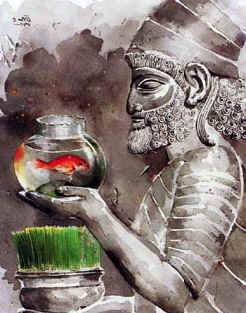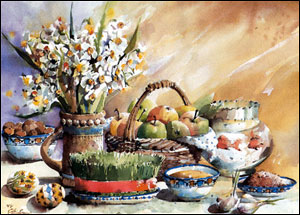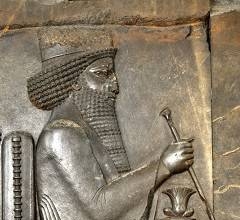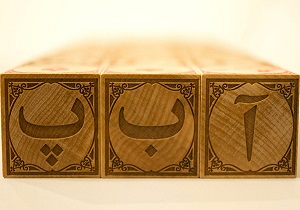The background of Nowruz - the first part

Abu Reyhan Bayroni considers Jamshid's flight to be the beginning of Nowruz celebration : Because Jamshid made a circle for himself,
On this day, he rode on it, and the jinn and devils carried him in the air, and he came to Babylon from Mount Damavand in one day, and the people were surprised to see this, and he celebrated this day and commemorates that day. They sit and swing.
According to Gardizi, Jamshid celebrated Nowruz thanks to God ” He took away heat, cold, sickness and death from people, and he was like this for three hundred years ” held and it was on this day that ” Jamshid sat on a calf and went to the south to fight the Diwan and the Blacks and fought with them and subdued them all.. ” And finally, Khayyam writes that Jamshid celebrated Nowruz on the occasion of the return of the sun to Aries.
…
The cause of Nowruz is that there are two cycles of the sun, one of which is that every three hundred and sixty-five Shaban days it returns to the first minute of the moon, and it cannot come back to the same day that it left, even if it is less than the duration every year. ; And when Jamshid received it that day ( that ) Nowruz was named and brought celebrations and rituals, and after that, kings and other people followed suit..
It is worth reminding that Nowruz celebration is held before Jamshid and Abu Rayhan, even though he attributes the celebration to Jamshid, reminds that, ” On that day, which was a new day, Jamshid took Eid; Although before that, Nowruz was great and great ” . Apart from Iran, in Asia Minor and Greece, we know that celebrations and rituals are held at the beginning of spring.. In the regions of Lydi and Phrygia, according to ancient myths, in honor of Sibel, the goddess of fertility and known as the mother of the gods, and the goddess Attis, a festival was held when the sun reached Aries and during the spring equinox.. Historians report that it was held during the time of August Shah in all the lands of Phrygia, Greece, Lydia and Anatolia.. Especially the great celebration and joy in three days 25 until the 28 March ( 4 until the 7 April ) .
Sadruddin Aini about Nowruz celebration in Tajikistan and Bukhara ( Uzbekistan ) May Noised: … Due to the first spring, at the time of the movement of all the plants, the arrival of this Eid, human nature also moves.. This is where the Tajiks say : ” Carrying, everything in action “. In fact, this Eid is the start of grain, seed and head crops ( the beginning ) Cultivation and other products of the earth are what feed man and cause his life to survive. He says in another place : in Bukhara ” Nowruz ” It is the national holiday of the Persian speaking people, they respected it a lot. Even religious mullahs gave Islamic religious color to this Eid, which was a national habit before Islamization, and people did not abandon this Eid even after becoming Muslim, and they benefited from it.. From the verses of the Quran, seven greetings are written to ” Gulong Water ” that his eating in Nowruz was more than the national habits, they ate it wet. But the glorious and reliable and universal celebration of this celebration in government institutions and governmental and non-governmental organizations and among all strata and social groups is undoubtedly one of the characteristics of Iran, which despite the wars and conflicts, failures and Political, social, religious, scientific and technical transformations have been left from ancient times, and in addition, they have entered other societies and cultures; And in comparison, today we don't know a society and a country with a celebration and ritual that lasts for several days, which is so universal and respected and believed by the special and the general, poor and rich, small and big, and finally urban and rural and nomadic..
Days or months of Nowruz celebration
The duration of celebrations such as Mehrgan, Yalda, Sedeh and many others is usually one day ( or one night ) It is not more. But Nowruz celebration, about which the term ” Jeshin Ha and Ein Hai Norouzi ” It is more telling, it lasts at least one or two weeks. Abu Rayhan Biruni writes that the duration of Nowruz celebration is one month after Jamshid :
Because Jam died, the kings celebrated all the days of this month. Eids were divided into six parts : 5 The first day was dedicated to the kings. 5 the second day to the nobles, the third day to the servants and employees of the kingdom, 5 The fourth day to Nadiman and courtiers. 5 The fifth day is given to the people and the sixth day to the farmers.

Kaempfer mentioned in his travelogue that during the time of Shah Suleiman Safavi, parties, entertainment and Nowruz celebrations in public squares lasted up to three weeks.. “Drew Will” He writes that the holiday period of Nowruz festival during the time of Feth Ali Shah is two weeks. But holding Nowruz ceremony today, at least from Panje and ” Last Wednesday of the year ” Beginning and end ” Thirteen badr ” It ends.
The customs and rituals of Nowruz, which have been inherited from one generation to the next generation since the ancient times, inevitably changed with the changes in lifestyles, industrial and mechanical technologies, administrative organizations, occupations, laws, and new means of mass communication. – As we will see – It has evolved without losing its identity. One of the old customs before Nowruz is Panje ( Five stolen ), he remembered Suri and house shaking.
claw ( Five stolen )
According to the ancient Iranian calendar, each of the twelve months of the year has thirty days, and the remaining five days make the year Panje, Panjek, Khamse Mostragha, Pitek.( In Mazandaran language and calendar ) Or Behizek ( On the day of Zoroastrian counting ) they say. Abu Rayhan writes about Panjah :
… Each of the Persian months has thirty days, and since the real year is three hundred and sixty-five days, Persians use the other five days of the year. ” claw ” And ” Entrance ” they say. Then this name is defined and ” stooped ” It was said, and these other five days are called Mustarqa days, because they are not counted in the number of any of the months. ….
These five days coincide with one of the six ” Ghanbar ” is, they are celebrating. The Panja ceremony was held until 1304, when the official calendar made the first six months of the year thirty-one days..
Celebrating Khumsa was popular among all social strata. so that in 1311 Hijri Qamar, a good-minded man in spending his endowment income, orders in Strak Kashan that : ” … The rest of the benefits of the endowment should be bought every year from the end of Khamseh Mustargah and distributed to all the people of the city, male and female, young and old. “. In Tabari's calendar, when Nowruz was celebrated in August, the paw ceremony was the same time as the celebration and day of Ab Pashan during the Safavid period. : … And His Highness Shahi Zal Allahi, by the order of the Behesht Asai Governor of Mazandaran, the government was successful, and when the refreshing season of spring passed, the air of that land turned warm, and the desire to watch the celebration and the feast of Panjah, who is addicted to the people of Gilan, went out of his mind.. It is the custom of the people of Gilan that in the days of Khumsa Mustarga every year, which according to the astrologers of that country, they have placed after the expiration of three months of spring, and among the people of Ajam, it is the day of water splashing; Big and small, male and female, come to the seashore, spend five days in procession, and all of them are stripped of their clothes, each group goes into the water with their family, plays with each other, and spends their time in this way. And al-Haq is a strange sight.
Mir Norozi
Among the rites of this five-day festival, which was not among the days of the year, month and work, for fun and entertainment, they would choose a ruler and an emir whose behavior and orders were funny, and at the end of the festival he would run away for fear of hurting the people.. Abu Rayhan mentions about a shark man who used to entertain people and catch something with his amazing and funny clothes and make-up on the first day of spring.. And he is the one who Hafez as “Mir Norozi” his reign ” More than five days ” does not know.
Masoudi writes about this : … It is the last five days of those days, on the first day of which in Iraq and Iran, a shark rides on its back ( And this is not a custom except in Iraq and the land of Ajam, and the people of Syria, Jazeera, Egypt, and Yemen do not know it )and let them eat and drink nutmeg, garlic, fatty meat and other hot foods and hot and cold-relieving drinks for a few days, and let them pretend to drive out the cold and pour cold water on them and not feel pain, and in Farsi call out: ” heat, heat” And this is the time of Eid al-Ajmian to dance and be happy during it.
From holding the ceremony of Mirnorozi, to 73 Last year, we have knowledge; Allameh Mohammad Qazvini in a valuable research about Mirnorouzi – which, like all its researches, is known to be late literary and cultural – He has given a description, which itself can be an ethnographic research, and I regretted that it would be enough to mention.
…. One of the author's trusted friends, one of the famous doctors, who used to reside in Khorasan, in response to my inquiry on this matter, sent me the following letter, which is included in its entirety. : ” In spring 1302 Hijri Shamsi, I had gone to Bojnourd for the treatment of an illness. I was there from the first of Farvardin until the fourteenth of Farvardin. On the tenth of Farvardin, I saw a large group of people passing by, on horseback and on foot.. A group of riders were moving in front and behind him. A group of foot soldiers, some of them holding sticks in their hands, were moving in front of him, on his sides, and behind him, some of them had long sticks in their hands, and on each stick was the head of an animal such as a cow or It was a sheep, that is, the bone of an animal's skull, and this symbol was because Amir had returned from a victorious war and was bringing the heads of his enemies with him.. Following this congregation, a large crowd of different people, big and small, were moving and making a lot of noise. I researched, they said that in Nowruz one person becomes an emir, who is the emir and ruler of the city until the thirteenth day of Eid, he gives money and money to the nobles and dignitaries of the city, which everyone gives more or less.. In this way, for example, he writes a decree for a particular person : – that you have to hand over one hundred thousand tomans to the house fund, of course, the meaning is that you have to pay one hundred tomans. Of course, these hundred tomans were increased and decreased, but in any case, something was said, most of the nobles gave something according to their desire.. Because, among the customs of Nowruz Eid, they took good fortune. Among other things, they gave Ilkhani a remittance amount, which he paid. After the end of the thirteen Eids, his emirate is periodically completed, and it seems that this occupation was hereditary in a family. “.
Undoubtedly, today, we see those who in the first days of April, with red clothes and blackened faces, in the alleys and passages and streets, who amuse people and get money by circling, singing and dancing, the remnants of jokes and Entertainment of choice ” Mir Norozi ” And ” Ruler of five days ” is that they are seen only on the days of Nowruz celebration, not on any other time and celebration; And they themselves say in the poems they read : Haji Firouzeh, New Year's Eve, a few days a year .
The days of the dead and the last Thursday of the year
One of the ancient rituals before Nowruz is remembering the dead, who go to the cemetery on this occasion and take food and give it to others.. Zoroastrians believe that : ” The soul of the dead never forgets the person they belonged to, and every year they return to their homes during the Farvardin festival. “.
In the days of Panjah, among the customs, preparing food was a religious ritual, writes Abu Rayhan.: … And during these five days, the pilgrims will put stew and wine, they will tell the souls of the dead, so that the soul of the dead will come and take that food.. Cooking food and taking it to the graves of the dead has been a custom in the fourth century; From Khwarazm to Fars : On the last five days of Esfand and the five days following it, like the people of Fars, the Khorezmians put food in the cemetery for the spirits of the dead..
One of the remaining forms of this custom is going to the cemetery in cities and villages ” Last Thursday of the year ” especially families who have lost a member during the year. Going to shrines and ” Visiting the graves “, on Thursday – And also, the day before Nowruz and the morning of the first day of the year – It is official. On this day, families feed ( rice stew )They put bread, halva and dates on the graves of their relatives and light candles or lamps on the graves of the recently passed away.. In some cities of Iran, the day before Eid, mourning families welcome their relatives and friends with food and halva and gather at the grave.. And it is also customary for Shia Iranians to visit the graves of imams and imamzadegan during the year of handover.
Shaking house
Idiom ” Shaking house ” It is mostly used for washing, cleaning, buying new, repairing tools, carpets, clothes, on the occasion of Nowruz.. In this moving house, which lasts for three to four weeks, all the tools and devices in the house must be moved, cleaned, repaired and inspected and put back in their place.. Some of the heavy tools, or carpets, panels, curtains and other devices, are moved and cleaned only once a year, that too in the Nowruz moving house.. In some cities of Azerbaijan, on the first Wednesday of March ( Wednesday) It is dedicated to washing and cleaning the carpets of the house.
This year, the moving house also spread to the moving house of the city : The official of urban services of Tehran Municipality said in an interview : Since Iranians clean their homes every year in the last days of the year based on a good tradition, Tehran Municipality is also in sync with the people in order to achieve a clean and tidy city. The collection of garbage and urban waste is carried out in 20 districts of Tehran municipality.
Planting greenery
March is the last month of winter, when seeds and grains are planted. planting ” Eid green ” Symbolically and as an omen, since ancient times, it is customary in all homes and among all families..
In ancient Iran, ” Twenty-five days before Nowruz, in the square of the city, twelve columns of raw clay were erected, on a column of wheat, a column of barley, and in that order, rice, beans, kajile. ( It is a plant from the citrus tree, whose stem is 50 It is centimeters )They planted millet, corn, beans, peas, sesame, lentils and mung beans; And on the sixth day of Farvardin, with songs and chants and joy, they dig these greens and spread them everywhere for good luck. “. And Abu Rayhan narrates that : ” This tradition remained stable among Iranians that on the day of Nowruz, they plant seven types of grains in seven cylinders next to the house and from the growth of these grains, they guess the good and bad of farming and the annual yield. “.
Today, it is customary in all homes that ten days or two weeks before Nowruz, in small and large dishes, bowls, plates, backs of jars and … Seeds such as wheat, lentils, mung beans, etc … They plant. Delivered and on the table at the time of year “Haft Sin ” They should put greens. In some cities of Azerbaijan, the third Wednesday is dedicated to soaking and planting wheat and lentils for Nowruz greens.. These greens are kept in the families until the thirteenth day, and on this day when for ” Thirteen badr ” They go out of the house, throw in the running water.
Haft-Sin
It is an old custom and belief that all the members of the family during the year of handover ( The moment the sun enters Aries ) They gather in their homes and houses next to the Haft Sin table. On the white table, there are seven food events, among others, which are written in letters ” س ” It begins, and it is a symbol and omen for the abundance of agricultural events and products – Such as apple, sabze, elderberry, sumac, garlic, vinegar, semno and the like- They put. In addition, a mirror, a candle, a bowl of milk, a bowl of water with an orange in it, a painted egg, an egg on the mirror, red fish, bread, vegetables, rose water, flowers, hyacinths, coins and religious books. ( The Muslims had the Koran and the Zoroastrians had the Avesta … ) It is also the decoration of Haft Sin table. This table is widespread in most houses until the thirteenth day.
| Haft-sin | |
| Ancient Sins (more common) |
|
| Other Sins | Susan, Sabzi, Sengak, Sepand, Black Seed, Coin, and Hyacinth are also sometimes used, but these are not Persian dialects..
|
| Other items |
|





